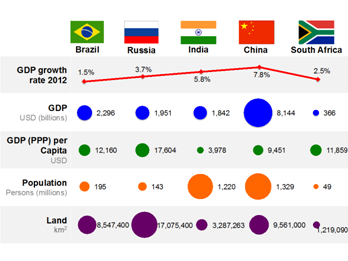State of BRICS Economies
The collective strength of the BRICS economies is of ever increasing importance to the global economy. The IMF has forecast growth in emerging markets and developing economies as being on track to build to 5.5 percent in 2013, the BRICS could largely benefit from that growth tide. Our strategic partnership within the BRICS alliance will have positive implications for trade and investment.
Data on the BRICS countries displays the relevance of the group in several dimensions: Brazil, Russia, India, China and South Africa together occupy about 26 percent of the planet's land, in addition to being home to 41 percent of world population and about 46 percent of its workforce. In 2012, with a combined GDP of approximately $14.9 trillion, the BRICS accounted for about 19 percent of world GDP in nominal terms and approximately 26 percent of global GDP in terms of purchasing power parity and an estimated US$4.5 trillion in combined foreign reserves. World GDP rose by 2.5% during the final quarter of 2012, largely because of these big emerging economies. The BRICS alone have been responsible for 55% of global growth since the end of 2009.
Although relatively new, the BRICS have established themselves on the global stage and have displayed that they can achieve increasingly broader consensus on intra-BRICS cooperation, as well as in pursuit of a more equitable and fair international financial system. More than 25 joint events were held throughout 2012, including Ministerial meetings in the areas of Finance, Trade, Agriculture, Health, among others. The significantly increased engagement, since the group first met in 2009, demonstrates the BRICS’ enhanced co-ordination and commitment to closer cooperation.

Source: Americas Market Intelligence | Global Intelligence Alliance
|
